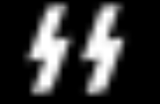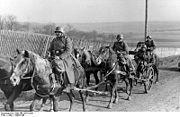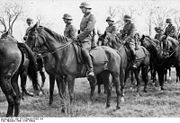
SS Cavalry Brigade
Encyclopedia
The SS Cavalry Brigade was a unit of the Waffen SS formed in 1940, from cavalry regiments created for occupation duties in German-occupied Poland
. Later, while serving in German-occupied areas of the Soviet Union
, the brigade was involved in the genocide of the Jewish population
and anti-partisan operations. It also filled gaps in the front line when called upon in emergencies. In 1942, the brigade was disbanded and became the cadre of the 8th SS Cavalry ("Florian Geyer") Division, during its formation.
 The SS Cavalry Brigade can trace its origin to the SS Totenkopf Horse Regiment , which was raised in September 1939, for internal security
The SS Cavalry Brigade can trace its origin to the SS Totenkopf Horse Regiment , which was raised in September 1939, for internal security
duties in Poland
, under the command of Hermann Fegelein
.
By April 1940, it consisted of 8 Saber Squadrons, 9th Replacement, 10th Heavy and 11th Technical Squadrons and a 12th Horse Battery of four 80mm guns. In May it was divided into two regiments, SS Totenkopf Horse Regiments 1 & 2, each of four squadrons, 5th Heavy and 6th Horse Battery also included were Signals, Engineer and Motorcycle platoons.
In March 1941 they were renamed SS Cavalry Regiments 1 and 2 and reformed again into 1st, 2nd and 3rd Saber Squadrons, 4th (Machine Gun
), 5th (Mortar
and Infantry Gun), 6th (Technical), 7th (Bicycle) and 8th (Horse Battery) Squadrons
In August 1941, the two regiments were formally created into the SS Cavalry Brigade under the command of Fegelein. Personnel were taken from the saber squadrons to form the brigade's Artillery , Engineer and Bicycle (Reconnaissance) Squadron's. They were also given a Light Anti-Aircraft Battery. The Brigade now had a strength of 3,500 men 2,900 horses and 375 vehicles.

After the German invasion of the Soviet Union
(Operation Barbarossa
), the SS Cavalry Brigade along with the 1 SS Infantry Brigade
was on the 19 July, reassigned to pacify what was seen as the main trouble spots in the occupied territories. The SS Cavalry Brigade was assigned to the area of the Pripet marsh
, a large area of land that covered parts of Belorussia and the Northern Ukraine
. Because it was more mobile and better able to carry out large-scale operations, the Brigade played a pivotal role in the transition from "selective mass murder" to the wholesale extermination of the Jewish population of the occupied part of the Soviet Union
.
On 27 July, the Brigade was ordered into action. by 1 August the SS Cavalry Regiment was responsible for the death of 800 people; five days later, on 6 August, this total had reached 3,000 "Jews and Partisans".
Also on 1 August, after a meeting between Heinrich Himmler
, Erich von Bach-Zelewski and Hinrich Lohse
, the Brigade received the following order:
Gustav Lombard
, on receiving the order, advised his Battalion that "In future not one male Jew is to remain alive not one family in the villages"
Throughout the next weeks, members of the SS Cavalry Regiment 1, under Lombard's command, murdered an estimated 11,000 Jews and more than 400 dispersed soldiers of the Red Army
.
Franz Magill and his men of the SS Cavalry Regiment 2, assisted in the roundup of all the men aged 18 to 55 in the city of Pinsk
, where 5,000 to 8,000 men were shot and shortly afterwards, another 2,000 residents including women, children and older men were executed.
General of Infantry Max von Schenckendorff, commander of Army Group Center described their operations the following way:
After the Soviet counter attack in January 1942, the only large formation not already committed was the SS Cavalry Brigade. Launching an attack on 7 January, it was also forced back after only one day's fighting when it had run out of ammunition. One of its Battalions also reported 75% casualties when fighting in the woods north of Rzhev
. The Brigade was found to be wanting and not equipped or trained to take on the Soviet Armoured units.
In March 1942, the SS Cavalry Brigade was used as the cadre in the formation of the 8th SS Cavalry Division Florian Geyer
General Government
The General Government was an area of Second Republic of Poland under Nazi German rule during World War II; designated as a separate region of the Third Reich between 1939–1945...
. Later, while serving in German-occupied areas of the Soviet Union
Soviet Union
The Soviet Union , officially the Union of Soviet Socialist Republics , was a constitutionally socialist state that existed in Eurasia between 1922 and 1991....
, the brigade was involved in the genocide of the Jewish population
The Holocaust in the USSR
Holocaust in the USSR refers to the genocide of Jews during the occupation of the USSR by Nazi Germany.- On the eve of the Holocaust :Beyond longstanding controversies, ranging from the Molotov-Ribbentrop Pact to anti-Zionism, the Soviet Union did grant official "equality of all citizens regardless...
and anti-partisan operations. It also filled gaps in the front line when called upon in emergencies. In 1942, the brigade was disbanded and became the cadre of the 8th SS Cavalry ("Florian Geyer") Division, during its formation.
Formation

Internal security
Internal security, or IS, is the act of keeping peace within the borders of a sovereign state or other self-governing territories. generally by upholding the national law and defending against internal security threats...
duties in Poland
Poland
Poland , officially the Republic of Poland , is a country in Central Europe bordered by Germany to the west; the Czech Republic and Slovakia to the south; Ukraine, Belarus and Lithuania to the east; and the Baltic Sea and Kaliningrad Oblast, a Russian exclave, to the north...
, under the command of Hermann Fegelein
Hermann Fegelein
SS-Obergruppenführer Hans Georg Otto Hermann Fegelein was a General of the Waffen-SS in Nazi Germany, a member of Adolf Hitler's entourage, brother-in-law to Eva Braun through his marriage to her sister, Gretl, and husband of the sister-in-law to Adolf Hitler through Hitler's marriage to Eva...
.
By April 1940, it consisted of 8 Saber Squadrons, 9th Replacement, 10th Heavy and 11th Technical Squadrons and a 12th Horse Battery of four 80mm guns. In May it was divided into two regiments, SS Totenkopf Horse Regiments 1 & 2, each of four squadrons, 5th Heavy and 6th Horse Battery also included were Signals, Engineer and Motorcycle platoons.
In March 1941 they were renamed SS Cavalry Regiments 1 and 2 and reformed again into 1st, 2nd and 3rd Saber Squadrons, 4th (Machine Gun
Machine gun
A machine gun is a fully automatic mounted or portable firearm, usually designed to fire rounds in quick succession from an ammunition belt or large-capacity magazine, typically at a rate of several hundred rounds per minute....
), 5th (Mortar
Mortar (weapon)
A mortar is an indirect fire weapon that fires explosive projectiles known as bombs at low velocities, short ranges, and high-arcing ballistic trajectories. It is typically muzzle-loading and has a barrel length less than 15 times its caliber....
and Infantry Gun), 6th (Technical), 7th (Bicycle) and 8th (Horse Battery) Squadrons
In August 1941, the two regiments were formally created into the SS Cavalry Brigade under the command of Fegelein. Personnel were taken from the saber squadrons to form the brigade's Artillery , Engineer and Bicycle (Reconnaissance) Squadron's. They were also given a Light Anti-Aircraft Battery. The Brigade now had a strength of 3,500 men 2,900 horses and 375 vehicles.
Soviet Union

After the German invasion of the Soviet Union
Soviet Union
The Soviet Union , officially the Union of Soviet Socialist Republics , was a constitutionally socialist state that existed in Eurasia between 1922 and 1991....
(Operation Barbarossa
Operation Barbarossa
Operation Barbarossa was the code name for Germany's invasion of the Soviet Union during World War II that began on 22 June 1941. Over 4.5 million troops of the Axis powers invaded the USSR along a front., the largest invasion in the history of warfare...
), the SS Cavalry Brigade along with the 1 SS Infantry Brigade
1 SS Infantry Brigade
The 1 SS Infantry Brigade was a unit of the German Waffen SS formed from former concentration camp guards for service in the Soviet Union behind the main front line during the Second World War. They conducted anti-partisan operations in the rear of the advancing German army and were involved in...
was on the 19 July, reassigned to pacify what was seen as the main trouble spots in the occupied territories. The SS Cavalry Brigade was assigned to the area of the Pripet marsh
Pinsk Marshes
The Pinsk Marshes or Pripyat Marshes are a vast territory of wetlands along the Pripyat River and its tributaries from Brest, Belarus to Mogilev and Kiev ....
, a large area of land that covered parts of Belorussia and the Northern Ukraine
Ukraine
Ukraine is a country in Eastern Europe. It has an area of 603,628 km², making it the second largest contiguous country on the European continent, after Russia...
. Because it was more mobile and better able to carry out large-scale operations, the Brigade played a pivotal role in the transition from "selective mass murder" to the wholesale extermination of the Jewish population of the occupied part of the Soviet Union
Soviet Union
The Soviet Union , officially the Union of Soviet Socialist Republics , was a constitutionally socialist state that existed in Eurasia between 1922 and 1991....
.
On 27 July, the Brigade was ordered into action. by 1 August the SS Cavalry Regiment was responsible for the death of 800 people; five days later, on 6 August, this total had reached 3,000 "Jews and Partisans".
Also on 1 August, after a meeting between Heinrich Himmler
Heinrich Himmler
Heinrich Luitpold Himmler was Reichsführer of the SS, a military commander, and a leading member of the Nazi Party. As Chief of the German Police and the Minister of the Interior from 1943, Himmler oversaw all internal and external police and security forces, including the Gestapo...
, Erich von Bach-Zelewski and Hinrich Lohse
Hinrich Lohse
Hinrich Lohse was a Nazi German politician, best known for his World War II rule of the Baltic states.-Early life:...
, the Brigade received the following order:
Explicit order by RFSS All Jews must be shot. Drive the female Jews into the swamps
Gustav Lombard
Gustav Lombard
Gustav Lombard was an SS Brigadeführer who served in World War II. During World War II, Lombard commanded the 8. SS-Division Florian Geyer, 23. SS-Mountain Division Kama and the 31. SS-Volunteer Grenadier Division...
, on receiving the order, advised his Battalion that "In future not one male Jew is to remain alive not one family in the villages"
Throughout the next weeks, members of the SS Cavalry Regiment 1, under Lombard's command, murdered an estimated 11,000 Jews and more than 400 dispersed soldiers of the Red Army
Red Army
The Workers' and Peasants' Red Army started out as the Soviet Union's revolutionary communist combat groups during the Russian Civil War of 1918-1922. It grew into the national army of the Soviet Union. By the 1930s the Red Army was among the largest armies in history.The "Red Army" name refers to...
.
Franz Magill and his men of the SS Cavalry Regiment 2, assisted in the roundup of all the men aged 18 to 55 in the city of Pinsk
Pinsk
Pinsk , a town in Belarus, in the Polesia region, traversed by the river Pripyat, at the confluence of the Strumen and Pina rivers. The region was known as the Marsh of Pinsk. It is a fertile agricultural center. It lies south-west of Minsk. The population is about 130,000...
, where 5,000 to 8,000 men were shot and shortly afterwards, another 2,000 residents including women, children and older men were executed.
General of Infantry Max von Schenckendorff, commander of Army Group Center described their operations the following way:
The SS Cavalry Brigade operates as follows: at dawn, without prior reconnaissance, the troop tasked with the inspection of a village rides into it at full speed and out the other end, occupies the outer edges of the village in a trice, in accordance with an agreed plan, and then gathers the whole population together, including women and children, for inspection. In many cases the skill and experience of the commanding officer, and also of the accompanying SDSDSD may refer to:* Salvia Divinorum* Southern Cross Decoration , a South African military award* Stage directions* Sisters of the Destitute, a Syro-Malabar Catholic women's order* Spasmodic dysphonia...
and GFPGeheime FeldpolizeiThe ' or GFP, was the secret military police of the German Wehrmacht until the end of Second World War. These units were used to carry out plain-clothed security work in the field such as counter-espionage, counter sabotage, detection of treasonable activities, counter-propaganda and to provide...
groups together with their interpreters, will decide upon the composition of the male inhabitants and their occupation, as well as upon their fate, so that the area is cleared of opposition and pacified.
After the Soviet counter attack in January 1942, the only large formation not already committed was the SS Cavalry Brigade. Launching an attack on 7 January, it was also forced back after only one day's fighting when it had run out of ammunition. One of its Battalions also reported 75% casualties when fighting in the woods north of Rzhev
Rzhev
Rzhev is a town in Tver Oblast, Russia, southwest of Staritsa and from Tver, on the highway and railway connecting Moscow and Riga. It is the uppermost town situated on the Volga River. Population:...
. The Brigade was found to be wanting and not equipped or trained to take on the Soviet Armoured units.
In March 1942, the SS Cavalry Brigade was used as the cadre in the formation of the 8th SS Cavalry Division Florian Geyer
Knight's Cross recipients
- Hermann FegeleinHermann FegeleinSS-Obergruppenführer Hans Georg Otto Hermann Fegelein was a General of the Waffen-SS in Nazi Germany, a member of Adolf Hitler's entourage, brother-in-law to Eva Braun through his marriage to her sister, Gretl, and husband of the sister-in-law to Adolf Hitler through Hitler's marriage to Eva...
, 02.03.1942 StandartenführerStandartenführerStandartenführer was a Nazi Party paramilitary rank that was used in the so-called Nazi combat-organisations: SA, SS, NSKK and the NSFK...
Brigade commander - Gustav LombardGustav LombardGustav Lombard was an SS Brigadeführer who served in World War II. During World War II, Lombard commanded the 8. SS-Division Florian Geyer, 23. SS-Mountain Division Kama and the 31. SS-Volunteer Grenadier Division...
10 March 1943
Footnotes
- Browning Christopher,The Origins of the Final Solution: The Evolution of Nazi Jewish Policy, September 1939-March 1942, University of Nebraska press, 2007, ISBN 0803259794
- Cuppers Martin Vorreiter der Shoah, Ein Vergleich der Einsätze der beiden SS-Kavallerieregimenter im August 1941, Meidenbauer Martin Verlag, 2006, ISBN 3899750802
- Fowler Jeffery T, Axis Cavalry in World War II, Osprey Publishing, 2001, ISBN 1841763233
- Ripley Tim, The Waffen-SS at War: Hitler's Praetorians 1925-1945, Zenitn Imprint, 2004, ISBN 0760320683

